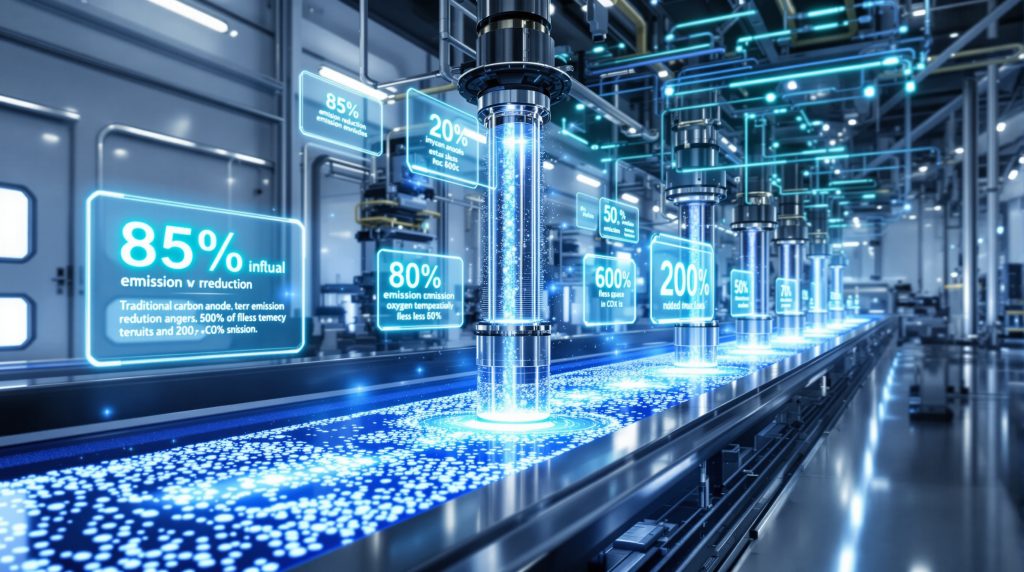Understanding Revolutionary Aluminium Production Technology
Inert anode aluminium technology represents a groundbreaking shift in metallurgical processes, fundamentally transforming how the world's most versatile metal is extracted and refined. This innovative approach replaces traditional carbon-based electrodes with advanced ceramic or metal alloy alternatives that remain stable throughout multiple production cycles, contributing to the broader mining industry evolution across various sectors.
The revolutionary nature of this technology lies in its complete elimination of direct carbon dioxide emissions during the smelting process. Traditional aluminium production consumes substantial quantities of carbon anodes, which oxidise during electrolysis to produce greenhouse gases. Inert anode systems generate pure oxygen as their primary byproduct, creating an entirely different electrochemical pathway that promises to decarbonise one of the world's most energy-intensive industrial processes.
What Makes Inert Anodes Different from Traditional Methods?
The fundamental difference between inert anode aluminium technology and conventional smelting lies in the electrode materials and resulting chemical reactions. Traditional Hall-Héroult processes rely on consumable carbon anodes that must be continuously replaced as they burn away during electrolysis. These carbon electrodes react with oxygen ions in the electrolyte to form carbon dioxide, contributing significantly to global industrial emissions.
Inert anodes, constructed from specially engineered ceramic composites or metal alloys, resist degradation in the harsh smelting environment. Operating at approximately 800°C, these non-consumable electrodes facilitate aluminum extraction while producing oxygen gas instead of carbon dioxide. This temperature reduction of roughly 160°C compared to traditional processes contributes to improved energy efficiency and reduced operational complexity.
Key Technical Specifications:
• Traditional Process: 960°C operating temperature, continuous carbon consumption
• Inert Anode Technology: 800°C operating temperature, zero electrode replacement
• Emission Profile: Oxygen production versus carbon dioxide generation
• Energy Requirements: Reduced power consumption through optimised thermal management
• Cell Configuration: Vertical electrode positioning for enhanced efficiency
Why This Technology Represents a Revolutionary Breakthrough
The significance of inert anode aluminium technology extends far beyond simple emission reductions. This innovation addresses multiple challenges simultaneously, from environmental impact to operational efficiency and product quality enhancement, aligning with comprehensive renewable energy transformations across industrial sectors.
Environmental Impact Transformation
Rio Tinto's successful implementation of a 450 kiloampere inert anode cell at their Alma smelter in Quebec demonstrates the technology's potential to eliminate direct carbon emissions from aluminium production entirely. According to Rio Tinto's breakthrough announcement, this achievement represents a core pillar of the company's long-term decarbonisation strategy.
The environmental benefits cascade through multiple levels:
• Direct Emission Elimination: Complete removal of process-related CO₂ generation
• Oxygen Generation: Pure oxygen production creates potential for industrial symbiosis
• Reduced Secondary Emissions: Elimination of perfluorocarbon gases and hydrogen fluoride
• Energy Efficiency: Lower operating temperatures reduce overall energy requirements
Production Quality Enhancements
ELYSIS President François Perras characterised the November 2025 milestone as turning vision into reality through years of relentless innovation. The technology produces superior aluminium quality by eliminating contamination risks associated with carbon anode dissolution, resulting in purer final products suitable for high-specification applications.
The absence of carbon-based materials in the electrode system prevents impurity introduction, maintaining consistent metal quality throughout production runs. This improvement particularly benefits aerospace, automotive, and electronics applications requiring stringent purity standards.
Technical Advantages of Inert Anode Systems
Operational Efficiency Improvements
| Performance Metric | Traditional Process | Inert Anode Technology | Advantage |
|---|---|---|---|
| Operating Temperature | 960°C | 800°C | 160°C reduction |
| Electrode Maintenance | Continuous replacement | Zero replacement | Eliminated downtime |
| Cell Footprint | Standard configuration | Compact vertical design | Space optimisation |
| Power Management | Fixed consumption | Modular feeding capability | Flexible operation |
| Safety Profile | Carbon handling risks | Reduced material handling | Enhanced worker safety |
Advanced Design Configuration
The vertical electrode positioning in inert anode cells exposes both surfaces to the electrolyte, maximising active surface area while minimising the distance between anode and cathode components. This configuration optimisation delivers equivalent aluminum output using approximately one-third of the physical space required by traditional horizontal pot-line designs.
The compact cell architecture enables more flexible facility layouts and potentially reduces capital infrastructure requirements for new installations. Additionally, the modular power feeding capabilities allow operators to manage electricity costs by adjusting consumption during peak and off-peak periods, supporting modern mine planning strategies focused on energy optimisation.
Enhanced Process Control
Inert anode systems provide superior process stability compared to traditional methods. The elimination of anode consumption variability creates more predictable operating conditions, reducing the need for constant adjustments and improving overall production consistency.
• Temperature Stability: Reduced thermal fluctuations improve cell performance
• Electrolyte Management: Consistent composition without carbon contamination
• Current Distribution: Optimised electrical characteristics for uniform aluminum deposition
• Process Monitoring: Simplified control systems without anode replacement scheduling
Challenges Requiring Resolution for Commercial Deployment
Material Science Engineering Requirements
Developing suitable inert anode materials presents complex metallurgical challenges that must be overcome for widespread commercial adoption. The electrode materials must simultaneously withstand multiple demanding conditions throughout extended operational periods.
Critical Material Properties:
• Corrosion Resistance: Withstand aggressive fluoride-based electrolytes at high temperatures
• Thermal Shock Resistance: Maintain integrity during temperature cycling operations
• Electrical Conductivity: Provide appropriate current-carrying capacity for industrial-scale production
• Mechanical Durability: Resist physical degradation from thermal expansion and contraction cycles
• Chemical Stability: Prevent oxidation or dissolution in the oxygen-rich environment
Process Integration Complexities
The implementation of inert anode aluminium technology requires significant modifications to traditional aluminium smelting processes. These changes extend beyond simple electrode replacement to encompass entire production system redesign.
Electrolyte Composition Challenges:
The successful operation of inert anode cells requires substantially higher oxide content in the electrolyte compared to conventional processes. This requirement necessitates advanced feed technology development to maintain optimal chemical balance throughout production cycles. Traditional alumina feeding systems may prove inadequate for the precise control needed in inert anode operations.
Energy Balance Considerations:
While inert anode technology offers numerous advantages, it presents unique energy requirements that differ from traditional carbon anode systems. The electrochemical processes generate oxygen rather than utilising the chemical energy stored in carbon materials, potentially affecting overall energy consumption profiles.
Complementary Technology Development:
Successful implementation requires compatible cathode materials and specialised electrolyte formulations. Titanium diboride cathode systems, while promising, require expensive modifications and careful integration with inert anode technology to achieve optimal performance.
Companies Leading Commercial Development Initiatives
Verified Industry Progress
ELYSIS Partnership Achievement
The collaboration between Rio Tinto and ELYSIS achieved a significant milestone in November 2025 with the successful startup of the first commercial-size 450 kiloampere inert anode cell. Located at Rio Tinto's Alma smelter in Quebec, Canada, this installation demonstrates industrial-scale viability and marks a critical transition from laboratory research to practical application.
This achievement reinforces Canada's position as a leader in sustainable aluminum production while showcasing the potential for broader technology deployment. Furthermore, the successful operation provides crucial performance data for scaling considerations and commercial viability assessments.
Construction of Demonstration Plant:
Rio Tinto has commenced construction of the first demonstration plant utilising inert anode technology at their Arvida smelter in Canada. This facility will provide comprehensive testing capabilities and serve as a proving ground for commercial-scale operations, generating essential operational experience for future deployments.
Industry Assessment and Future Deployment
The Australian Aluminium Council has identified inert anode aluminium technology as highly promising with potential for wider deployment over the next five years. The organisation specifically noted the technology's applicability to both new and existing smelter facilities, including operations throughout Australia's aluminum production network.
This assessment suggests growing industry confidence in the technology's commercial viability and indicates potential for international expansion beyond the initial North American implementations. The flexibility to retrofit existing facilities could accelerate adoption timelines compared to technologies requiring entirely new infrastructure.
Economic Benefits and Market Transformation
Operational Cost Optimisation
Inert anode aluminium technology offers multiple pathways for cost reduction throughout the production lifecycle. The elimination of continuous anode replacement removes a significant operational expense while reducing labour requirements for maintenance activities, contributing to broader decarbonisation benefits across industrial operations.
Direct Cost Reductions:
• Material Costs: Zero requirement for carbon anode purchasing and replacement
• Labour Expenses: Reduced maintenance staffing for electrode changing operations
• Transportation Costs: Elimination of carbon anode logistics and waste management
• Storage Requirements: Reduced facility space needs for anode inventory management
Energy Cost Management
The modular power feeding capabilities of inert anode systems enable sophisticated energy cost management strategies. Operators can adjust electricity consumption based on grid pricing, potentially reducing energy expenses during peak rate periods while maintaining production targets.
This flexibility becomes particularly valuable in regions with time-of-use electricity pricing or high renewable energy penetration, where power costs vary significantly throughout daily cycles.
Capital Investment Implications
The compact design of inert anode cells could reduce infrastructure requirements for new smelting facilities. The smaller physical footprint enables more efficient facility layouts while potentially lowering construction costs for greenfield projects.
Additionally, the technology's applicability to existing facilities creates retrofit opportunities that may prove more economically attractive than complete facility replacement for aging smelting operations.
Industry Transformation Through Zero-Carbon Production
Decarbonisation Pathway Implementation
Inert anode technology provides the aluminium industry with a clear technological pathway toward achieving carbon neutrality goals. Unlike approaches that rely on carbon offsetting or renewable energy alone, this technology eliminates process emissions at their source while maintaining production efficiency, supporting the wider sustainability transformation occurring across extractive industries.
The successful demonstration at commercial scale validates the technology's potential to address one of the most challenging aspects of metals production decarbonisation. As environmental regulations tighten globally and carbon pricing mechanisms expand, early adoption of emission-free production technologies may provide significant competitive advantages.
Supply Chain Integration Opportunities
The oxygen generation capability creates potential for industrial symbiosis arrangements where aluminum smelting operations could supply oxygen to adjacent industries requiring this resource. Steel production, chemical manufacturing, and water treatment facilities represent potential integration partners that could benefit from reliable oxygen supplies.
Such arrangements could provide additional revenue streams while optimising resource utilisation across industrial complexes. Consequently, the economic benefits of oxygen sales could further improve the financial attractiveness of inert anode technology adoption.
Scalability and Timeline Considerations
The Australian Aluminium Council's assessment that inert anode technology could be deployed more widely over the next five years provides a realistic timeline for industry transformation. The technology's potential application to both new and existing smelters, including Australian operations, suggests broad deployment possibilities.
The transition from demonstration projects to commercial deployment appears to be accelerating, with material science challenges increasingly focused on manufacturing consistency and cost optimisation rather than fundamental feasibility questions.
Future Prospects for Zero-Carbon Aluminium Production
Technology Maturation Trajectory
The successful operation of commercial-size inert anode cells represents a critical inflection point in technology development. Current progress suggests the industry is transitioning from proof-of-concept demonstrations to practical implementation planning, with fundamental technical barriers largely resolved.
Manufacturing challenges now centre on producing consistent, cost-effective electrode materials at industrial scale while optimising process integration for maximum efficiency. These manufacturing and scaling considerations represent the next phase of development rather than basic research questions.
Global Market Adoption Drivers
As environmental regulations intensify and carbon pricing mechanisms expand internationally, inert anode aluminium technology adoption may accelerate beyond voluntary sustainability initiatives. Early adopters could gain substantial competitive advantages through lower-carbon product offerings and reduced regulatory compliance costs.
The technology's ability to eliminate direct process emissions while improving operational efficiency positions it as essential infrastructure for sustainable metallurgy in an increasingly carbon-constrained global economy.
Industrial Integration and Network Effects
The compact design and improved efficiency characteristics of inert anode systems could enable more distributed aluminium production networks closer to end-use markets. This geographic optimisation may reduce transportation costs and supply chain complexity while providing greater supply security for regional markets.
The convergence of environmental requirements, operational benefits, and improving economic viability establishes inert anode technology as a transformative force for sustainable aluminium production. As the industry continues developing this revolutionary approach, it promises to fundamentally reshape one of the world's most important industrial processes while contributing significantly to global decarbonisation efforts.
Disclaimer: This article contains information about emerging industrial technologies and market developments. Readers should conduct independent research and consult with industry professionals before making investment or business decisions based on the information presented. Technology performance claims and market projections are subject to change as development continues and market conditions evolve.
Ready to Invest in the Next Revolutionary Mining Technology?
Discovery Alert's proprietary Discovery IQ model instantly alerts subscribers to significant ASX mineral discoveries, including breakthrough technologies like inert anode aluminium production that could transform entire industries. Explore how major technological breakthroughs and mineral discoveries have historically generated substantial market returns by visiting Discovery Alert's dedicated discoveries page and begin your 30-day free trial today to position yourself ahead of the market.




